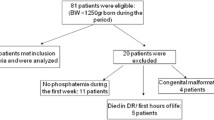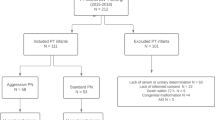Abstract
To investigate perinatal factors and early morbidities associated with early serum phosphate (sPhos) levels in a cohort of preterm infants. Retrospective data were obtained from the medical records of a cohort of 454 infants born at < 32 weeks gestational age. Serum phosphate levels were directly associated with gestational age, body weight z-score, and Apgar scores and inversely associated with timing of enteral nutrition initiation and diet consisting of mostly breast milk. Maternal hypertension, lactate levels, early symptomatic hypotension, and total protein supplemented on days 1 to 3 were also inversely associated with sPhos. Morbidities that were found to be associated with sPhos did not persist after adjustment for confounding factors.
Conclusions: We report a novel association between early sPhos and timing and content of enteral nutrition, as well as with the early neonatal hemodynamic condition of preterm infants. This information may help identify infants at risk for low sPhos and aid in the nutritional strategy utilized in these patients. This study did not identify early morbidities associated with sPhos.
What is Known: • High initial amino acid intake is associated with increased risk of Refeeding like syndrome and hypophosphatemia, among preterm infants. What is New: • Early enteral nutrition, starting within the first 72 h of life, is associated with higher serum phosphate (sPhos) compared to nothing per os (NPO). • sPhos was not associated with early adverse neonatal outcomes. |



Similar content being viewed by others
Abbreviations
- BW:
-
birth weight
- GA:
-
gestational age
- IVH:
-
intraventricular hemorrhage
- NEC:
-
necrotizing enterocolitis
- NICU:
-
neonatal intensive care units
- PI-ReFeeding syndrome:
-
placental incompletely restored feeding syndrome
- PN:
-
parenteral nutrition
- PVL:
-
periventricular leukomalacia
- SGA:
-
small for gestational age
- sPhos:
-
serum Phosphor levels
References
Skipper A (2012) Refeeding syndrome or refeeding hypophosphatemia: a systematic review of cases. Nutr Clin Pract. https://doi.org/10.1177/0884533611427916
Patel U, Sriram K (2009) Acute respiratory failure due to refeeding syndrome and hypophosphatemia induced by hypocaloric enteral nutrition. Nutrition. https://doi.org/10.1016/j.nut.2008.09.011
Bonsante F, Iacobelli S, Latorre G et al (2013) Initial amino acid intake influences phosphorus and calcium homeostasis in preterm infants - it is time to change the composition of the early parenteral nutrition. PLoS One. https://doi.org/10.1371/journal.pone.0072880
Antachopoulos C, Margeli A, Giannaki M, Bakoula C, Liakopoulou T, Papassotiriou I (2002) Transient hypophosphataemia associated with acute infectious disease in paediatric patients. Scand J Infect Dis. https://doi.org/10.1080/0036554021000026960
Igarashi A, Okuno T, Ohta G, Tokuriki S, Ohshima Y (2017) Risk factors for the development of refeeding syndrome-like hypophosphatemia in very low birth weight infants. Dis Markers. https://doi.org/10.1155/2017/9748031
Ichikawa G, Watabe Y, Suzumura H, Sairenchi T, Muto T, Arisaka O (2012) Hypophosphatemia in small for gestational age extremely low birth weight infants receiving parenteral nutrition in the first week after birth. J Pediatr Endocrinol Metab. https://doi.org/10.1515/jpem-2011-0485
Ross JR, Finch C, Ebeling M, Taylor SN (2013) Refeeding syndrome in very-low-birth-weight intrauterine growth-restricted neonates. J Perinatol 33:717–720. https://doi.org/10.1038/jp.2013.28
Valentine CJ, Fernandez S, Rogers LK et al (2009) Early amino-acid administration improves preterm infant weight. J Perinatol. https://doi.org/10.1038/jp.2009.51
Dinerstein A, Nieto RM, Solana CL, Perez GP, Otheguy LE, Larguia AM (2006) Early and aggressive nutritional strategy (parenteral and enteral) decreases postnatal growth failure in very low birth weight infants. J Perinatol. https://doi.org/10.1038/sj.jp.7211539
Ibrahim M, Jones LJ, Lai NM, Tan K (2016) Dexmedetomidine for analgesia and sedation in newborn infants receiving mechanical ventilation. Cochrane Database Syst Rev. https://doi.org/10.1002/14651858.CD012361
Lucas A, Morley R, Cole TJ et al (1990) Early diet in preterm babies and developmental status at 18 months. Lancet. https://doi.org/10.1016/0140-6736(90)93026-L
Sakurai M, Itabashi K, Sato Y, Hibino S, Mizuno K (2008) Extrauterine growth restriction in preterm infants of gestational age ≤32 weeks. Pediatr Int. https://doi.org/10.1111/j.1442-200X.2007.02530.x
Mizumoto H, Mikami M, Oda H, Hata D (2012) Refeeding syndrome in a small-for-dates micro-preemie receiving early parenteral nutrition. Pediatr Int. https://doi.org/10.1111/j.1442-200X.2012.03590.x
Boubred F, Herlenius E, Bartocci M, Jonsson B, Vanpée M (2015) Extremely preterm infants who are small for gestational age have a high risk of early hypophosphatemia and hypokalemia. Acta Paediatr Int J Paediatr. https://doi.org/10.1111/apa.13093
Christmann V, De Grauw AM, Visser R, Matthijsse RP, Van Goudoever JB, Van Heijst AFJ (2014) Early postnatal calcium and phosphorus metabolism in preterm infants. J Pediatr Gastroenterol Nutr. https://doi.org/10.1097/MPG.0000000000000251
Moltu SJ, Strømmen K, Blakstad EW et al (2013) Enhanced feeding in very-low-birth-weight infants may cause electrolyte disturbances and septicemia - a randomized, controlled trial. Clin Nutr. https://doi.org/10.1016/j.clnu.2012.09.004
Senterre T, Zahirah IA, Pieltain C, De Halleux V, Rigo J (2015) Electrolyte and mineral homeostasis after optimizing early macronutrient intakes in VLBW infants on parenteral nutrition. J Pediatr Gastroenterol Nutr. https://doi.org/10.1097/MPG.0000000000000854
Boateng AA, Sriram K, Meguid MM, Crook M (2010) Refeeding syndrome: treatment considerations based on collective analysis of literature case reports. Nutrition. https://doi.org/10.1016/j.nut.2009.11.017
Mulla S, Stirling S, Cowey S et al (2017) Severe hypercalcaemia and hypophosphataemia with an optimised preterm parenteral nutrition formulation in two epochs of differing phosphate supplementation. Arch Dis Child Fetal Neonatal Ed. https://doi.org/10.1136/archdischild-2016-311107
Pająk A, Królak-Olejnik B, Szafrańska A (2018) Early hypophosphatemia in very low birth weight preterm infants. Adv Clin Exp Med. https://doi.org/10.17219/acem/70081
Fenton TR, Kim JH (2013) A systematic review and meta-analysis to revise the Fenton growth chart for preterm infants. BMC Pediatr. https://doi.org/10.1186/1471-2431-13-59
Papile LA, Burstein J, Burstein R, Koffler H (1978) Incidence and evolution of subependymal and intraventricular hemorrhage: a study of infants with birth weights less than 1,500 gm. J Pediatr. https://doi.org/10.1016/S0022-3476(78)80282-0
Kliegman RM, Walsh MC (1987) Neonatal necrotizing enterocolitis: pathogenesis, classification, and spectrum of illness. Curr Probl Pediatr. https://doi.org/10.1016/0045-9380(87)90031-4
Greer FR (2016) Calcium and phosphorus and the preterm infant. Neoreviews. https://doi.org/10.1542/neo.17-4-e195
Mihatsch W, Fewtrell M, Goulet O et al (2018) ESPGHAN/ESPEN/ESPR/CSPEN guidelines on pediatric parenteral nutrition: calcium, phosphorus and magnesium. Clin Nutr. https://doi.org/10.1016/j.clnu.2018.06.950
Author information
Authors and Affiliations
Contributions
Dr. Daniel Yakubovich made substantial contributions to the study design, data analysis, and interpretation as well as for the manuscript preparation.
Dr. Tzipi Strauss made substantial contributions to conception and design, made substantial contributions to interpretation of results, critically revised the manuscript, and gave the final approval of the version to be published.
Dr. Dror Ohana, Dr. Camelia Taran, and Dr. Ori Snapiri, made substantial contributions to study design, data collection, and interpretation of results; critically revised the manuscript; and gave final approval of the version to be published.
Ms. Dalia Limor Karol provided assistance with data acquisition, the manuscript preparation, including review of each version of the manuscript, and gave final approval of the version to be published.
Dr. Orna Starez- Chaham and Dr. Abraham Tsur made substantial contributions to study design, provided assistance with interpretation of results and manuscript preparation, and gave final approval of the version to be published.
Mrs. Brigitte Kochavi made substantial contributions to conception and design, critically revised the manuscript, and gave final approval of the version to be published.
Dr. Iris Morag is the principal investigators, made substantial contributions to conception and design, provided supervision with all aspects of the research including study design and data collection, made substantial contributions to interpretation of results, and critically revised the manuscript, final approval of the version to be published.
Corresponding author
Ethics declarations
Conflict of interest
The authors declare that they have no conflict of interest.
Ethical approval
This article does not contain any studies with human participants or animals performed by any of the authors.
Informed consent
The study protocol has been approved by the institute’s committee on human research (3739-16-SMC) and this committee waived the need for consent.
Additional information
Communicated by Daniele De Luca
Publisher’s note
Springer Nature remains neutral with regard to jurisdictional claims in published maps and institutional affiliations.
Electronic supplementary material
ESM 1
(DOCX 40 kb)
Rights and permissions
About this article
Cite this article
Yakubovich, D., Strauss, T., Ohana, D. et al. Factors associated with early phosphate levels in preterm infants. Eur J Pediatr 179, 1529–1536 (2020). https://doi.org/10.1007/s00431-020-03622-7
Received:
Revised:
Accepted:
Published:
Issue Date:
DOI: https://doi.org/10.1007/s00431-020-03622-7




